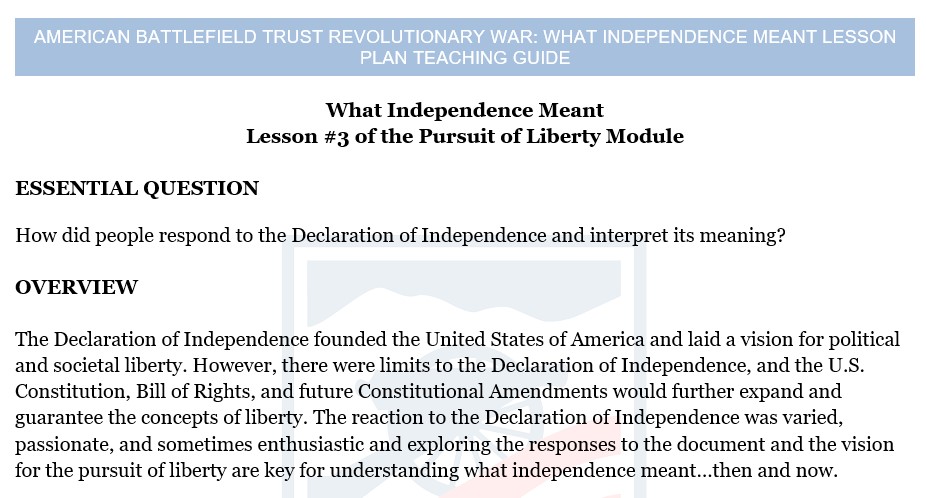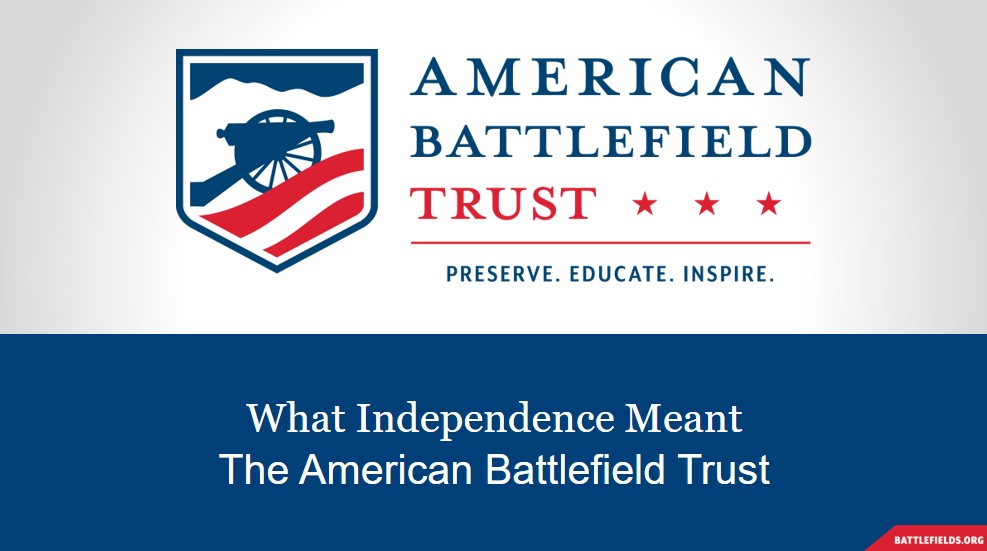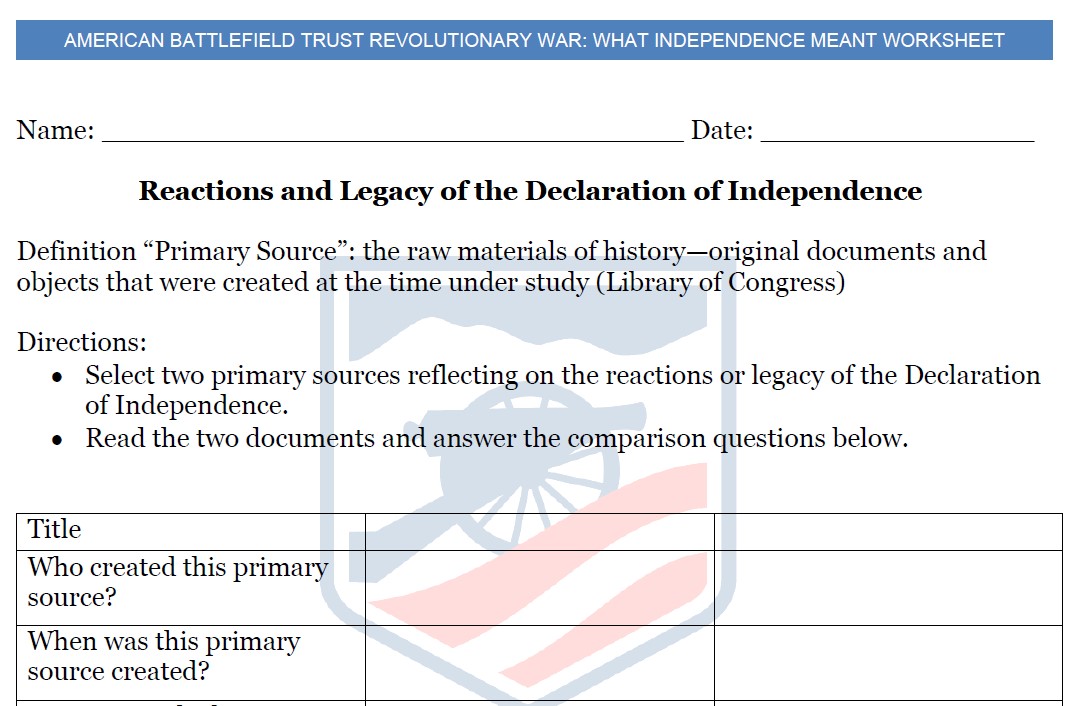What Independence Meant Lesson Plan
A lesson plan for use in middle and high school classrooms.
The Declaration of Independence founded the United States of America and laid a vision for political and societal liberty. However, there were limits to the Declaration of Independence, and the U.S. Constitution, Bill of Rights, and future Constitutional Amendments would further expand and guarantee the concepts of liberty. The reaction to the Declaration of Independence was varied, passionate, and sometimes enthusiastic and exploring the responses to the document and the vision for the pursuit of liberty are key for understanding what independence meant…then and now.
This Lesson Plan can be used as a prepared resource by following this curriculum plan which aligns to NCSS and Common Core Standards.
This Lesson Plan's assets can also be used on their own as supplemental resources. The display format is prepared for easy access, exploring, and learning.
The Pursuit of Liberty Module
Upon completion of this lesson, the students will be able to:
1. Knowledge
- Describe some of the outcomes of the Declaration of Independence, specifically the founding of the United States and a document that outlined a concept for liberty.
- Discuss the importance of the Declaration of Independence in the pursuit of liberty within the United States and in other nations.
2. Comprehension/Application/Analysis
- Examine and analyze some of the reactions and responses to the Declaration of Independence.
3. Evaluation
- Evaluate the foundations of liberty conveyed by the Declaration of Independence and how they have been expanded over the years in the pursuit of liberty.
Check out the Lesson Plan Teaching Guide for more instructions on using the prepared Lesson Plan.
Lesson Plan Primary Source Activity:
- Use the Lesson’s PowerPoint to explore the context and history; the PowerPoint introduces Essential Questions and lays foundational knowledge about the conflict.
- Watch the video “Declaration of Independence In4”
- As a class, in groups, or individually, have the students choose two primary sources to study.
- Selected primary sources are available under the “Primary Source” section this lesson plan page. (“Jefferson and Slavery” and “Declaration of the Rights of Man” will NOT be easy to use in the worksheet activity.)
- Distribute the primary source worksheet.
- Have the students fill out the primary source worksheet; they can share some of the details, comparisons, and conclusions with the rest of the class.
OPTIONAL HOMEWORK/ASSESSMENT/ADDITIONAL ACTIVITIES:
Option 1: Europe and the Declaration of Independence
Students can research the reaction of Europeans to the Declaration of Independence. How did the Declaration reflect Enlightenment ideals and inspire others to support the Americans in the Revolutionary War? Students can share their findings as an essay or in a more interactive activity, perhaps including a first-person report with costumes or props.
On the Lesson Plan Page, there are several biographies, primary sources, and secondary sources (articles) which will be a helpful starting point for this research/activity.
Option 2: Pursuit of Liberty Discussion
Students can find definitions for Liberty, and then encourage a class discussion about what Liberty meant in the 1770s. Does it mean something similar or different now? What are responsibilities that come with liberty? What are some of your personal experiences with liberty protected or limited? What do you see as obstacles to the pursuit of liberty? How do we overcome those challenges in the pursuit of liberty?
Common Core State Standards- ELA & History/Social Studies
Grades 6-8
- Key Ideas and Details:
- CCSS.ELA-LITERACY.RH.6-8.2
- Determine the central ideas or information of a primary or secondary source; provide an accurate summary of the source distinct from prior knowledge or opinions.
- CCSS.ELA-LITERACY.RH.6-8.2
- Craft and Structure:
- CCSS.ELA-LITERACY.RH.6-8.6
- Identify aspects of a text that reveal an author's point of view or purpose (e.g., loaded language, inclusion or avoidance of particular facts).
- CCSS.ELA-LITERACY.RH.6-8.6
- Integration of Knowledge and Ideas:
- CCSS.ELA-LITERACY.RH.6-8.8
- Distinguish among fact, opinion, and reasoned judgment in a text.
- CCSS.ELA-LITERACY.RH.6-8.8
Grades 9-10
- Key Ideas and Details:
- CCSS.ELA-LITERACY.RH.9-10.1
- Cite specific textual evidence to support analysis of primary and secondary sources, attending to such features as the date and origin of the information.
- CCSS.ELA-LITERACY.RH.9-10.2
- Determine the central ideas or information of a primary or secondary source; provide an accurate summary of how key events or ideas develop over the course of the text.
- CCSS.ELA-LITERACY.RH.9-10.3
- Analyze in detail a series of events described in a text; determine whether earlier events caused later ones or simply preceded them.
- CCSS.ELA-LITERACY.RH.9-10.1
- Craft and Structure:
- CCSS.ELA-LITERACY.RH.9-10.5
- Analyze how a text uses structure to emphasize key points or advance an explanation or analysis.
- CCSS.ELA-LITERACY.RH.9-10.6
- Compare the point of view of two or more authors for how they treat the same or similar topics, including which details they include and emphasize in their respective accounts.
- CCSS.ELA-LITERACY.RH.9-10.5
- Integration of Knowledge and Ideas:
- CCSS.ELA-LITERACY.RH.9-10.9
- Compare and contrast treatments of the same topic in several primary and secondary sources.
- CCSS.ELA-LITERACY.RH.9-10.9
Grades 11-12
- Key Ideas and Details:
- CCSS.ELA-LITERACY.RH.11-12.1
- Cite specific textual evidence to support analysis of primary and secondary sources, connecting insights gained from specific details to an understanding of the text as a whole.
- CCSS.ELA-LITERACY.RH.11-12.2
- Determine the central ideas or information of a primary or secondary source; provide an accurate summary that makes clear the relationships among the key details and ideas.
- CCSS.ELA-LITERACY.RH.11-12.1
- Craft and Structure:
- CCSS.ELA-LITERACY.RH.11-12.5
- Analyze in detail how a complex primary source is structured, including how key sentences, paragraphs, and larger portions of the text contribute to the whole.
- CCSS.ELA-LITERACY.RH.11-12.6
- Evaluate authors' differing points of view on the same historical event or issue by assessing the authors' claims, reasoning, and evidence.
- CCSS.ELA-LITERACY.RH.11-12.5
- Integration of Knowledge and Ideas:
- CCSS.ELA-LITERACY.RH.11-12.8
- Evaluate an author's premises, claims, and evidence by corroborating or challenging them with other information.
- CCSS.ELA-LITERACY.RH.11-12.9
- Integrate information from diverse sources, both primary and secondary, into a coherent understanding of an idea or event, noting discrepancies among sources.
- CCSS.ELA-LITERACY.RH.11-12.8
Social Studies - National Council for the Social Studies
- Theme 2: Time, Continuity, and Change
- Theme 5: Individuals, Groups, and Institutions
- Theme 6: Power, Authority, and Governance
- Theme 9: Global Connections
- Theme 10: Civic Ideals and Practices
This Lesson plan
contains the following:
3 Activities | 21 Resources
Audience: Middle school | High school
This Lesson plan is a part of:
Revolutionary War Curriculum | The Pursuit of Liberty Module




